Artists
-
Max Ackermann
(Berlin 1887 - 1975 Unterlengenhardt (Schwarzwald))
-
Gerhard Altenbourg
(Rödichen-Schnepfenthal bei Waltershausen 1926 - 1989 Meißen)
-
Friedel Anderson
(* 1954 Oberhausen)
-
Eugen Batz
(Velbert 1905 - 1986 Wuppertal)
-
Rolf Cavael
(Königsberg 1898 - 1979 München)
-
Dottore
(Dresden 1935 - 2009 Hamburg)
-
Petra Flemming
(Großsteinberg 1944 - 1988 Arnstadt bei Erfurt)
-
Eberhard Freudenreich
(* 1963 Bad Urach)
-
Klaus Fußmann
(* 1938 Velbert)
-
Martina Geist
(* 1961 Stuttgart)
-
Hermann Glöckner
(Cotta bei Dresden 1889 - 1987 Westberlin)
-
Herta Günther
(Dresden 1934 - 2018 ebenda)
-
Kurt Günther
(Gera 1893 - 1955 Stadtroda)
-
Angela Hampel
(* 1956 Räckelwitz bei Kamenz)
-
Robert Häusser
(Stuttgart 1924 - 2013 Mannheim)
-
Erich Heckel
(Döbeln 1883 - 1970 Radolfzell)
-
Josef Hegenbarth
(Kamnitz (Böhmen) 1884 - 1962 Dresden)
-
Gussy Hippold-Ahnert
(Berlin 1910 - 2003 Radebeul)
-
Ralf Kerbach
(* 1956 Dresden)
-
Ida Kerkovius
(Riga 1879 - 1970 Stuttgart)
-
Edmund Kesting
(Dresden 1892 - 1970 Birkenwerder)
-
Ernst Ludwig Kirchner
(Aschaffenburg 1880 - 1938 Frauenkirch-Wildboden bei Davos/Schweiz)
-
Siegfried Klotz
(Oberschlema/Erzgebirge 1939 - 2004 Dresden)
-
Herbert Kunze
(Chemnitz 1913 - 1981 Dresden)
-
Paula Lauenstein
(Dresden 1898 - 1980 Crostau)
-
Ulrich Lindner
(* 1938 Dresden)
-
Carl Lohse
(Hamburg 1895 - 1965 Bischofswerda)
-
Wilhelm Müller
(Harzgerode 1928 - 1999 Dresden)
-
Igor Oleinikov
(* 1968 Krasnodar)
-
Otto Pankok
(Mülheim a.d. Ruhr 1893 - 1966 Wesel)
-
Otto Piene
(Laasphe 1928 - 2014 Berlin)
-
Ana Pireva
(* 1995 Shumen, Bulgarien)
-
Stefan Plenkers
(* 1945 Ebern bei Bamberg)
-
Tanja Pohl
(* 1985 Lengenfeld (Vogtland))
-
Mona Pourebrahim
(* 1985 Teheran, Iran)
-
Otto Ritschl
(Erfurt 1885 - 1976 Wiesbaden)
-
Richard Sander
(Glogau 1906 - 1987 Cossebaude)
-
Heinz Schanz
(Genkingen (Kreis Reutlingen) 1927 - 11/10 Karlsruhe)
-
Helmut Schmidt-Kirstein
(Aue/Erzgebirge 1909 - 1985 Dresden)
-
Annette Schröter
(* 1956 Meissen)
-
Aren Shahnazaryan
(* 1991)
-
Heinrich Siepmann
(1904 - Mülheim/Ruhr - 2002)
-
Max Uhlig
(* 1937 Dresden)
-
Emilio Vedova
(1919 - Venedig - 2006)
-
Conrad Westpfahl
(Berlin 1891 - 1976 Wetzhausen)
-
Felina Wießmann
(* 1995 Dortmund)
-
Albert Wigand
(Ziegenhain (Hessen) 1890 - 1978 Leipzig)
-
Werner Wittig
(Chemnitz 1930 - 2013 Radebeul)
-
Tillmann Ziola
(* 1990 Braunschweig)
-
Shengjie Zong
(* 1989 Wuxi (China))
